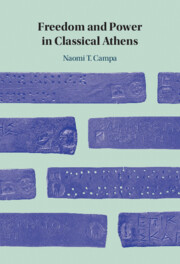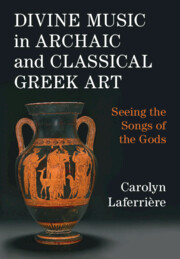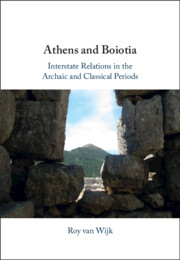82 results
Chapter 2 - Acting versus Sincerity
-
- Book:
- Democracy, Theatre and Performance
- Published online:
- 17 May 2024
- Print publication:
- 27 June 2024, pp 39-62
-
- Chapter
- Export citation
Chapter 4 - Aeschylus’ Persians
-
- Book:
- Choral Tragedy
- Published online:
- 25 April 2024
- Print publication:
- 02 May 2024, pp 93-111
-
- Chapter
- Export citation

Freedom and Power in Classical Athens
-
- Published online:
- 04 April 2024
- Print publication:
- 11 April 2024
Interorganizational Knowledge Transfer in Mass Gatherings: Exploring the Health and Safety Stakeholders’ Perceptions Participating in the Athens Marathon
-
- Journal:
- Prehospital and Disaster Medicine / Volume 39 / Issue 2 / April 2024
- Published online by Cambridge University Press:
- 15 March 2024, pp. 163-169
- Print publication:
- April 2024
-
- Article
-
- You have access
- Open access
- HTML
- Export citation
One - Sculpting Divine Music
-
- Book:
- Divine Music in Archaic and Classical Greek Art
- Published online:
- 01 February 2024
- Print publication:
- 29 February 2024, pp 30-71
-
- Chapter
- Export citation
Introduction
-
- Book:
- Divine Music in Archaic and Classical Greek Art
- Published online:
- 01 February 2024
- Print publication:
- 29 February 2024, pp 1-29
-
- Chapter
- Export citation

Divine Music in Archaic and Classical Greek Art
- Seeing the Songs of the Gods
-
- Published online:
- 01 February 2024
- Print publication:
- 29 February 2024

Athens and Boiotia
- Interstate Relations in the Archaic and Classical Periods
-
- Published online:
- 29 February 2024
- Print publication:
- 25 January 2024
-
- Book
-
- You have access
- Open access
- Export citation
5 - Contested Memories
-
- Book:
- Athens and Boiotia
- Published online:
- 29 February 2024
- Print publication:
- 25 January 2024, pp 279-381
-
- Chapter
-
- You have access
- Open access
- HTML
- Export citation
1 - Introduction
-
- Book:
- Athens and Boiotia
- Published online:
- 29 February 2024
- Print publication:
- 25 January 2024, pp 1-11
-
- Chapter
-
- You have access
- Open access
- HTML
- Export citation
Chapter 4 - The Freedom of the Greeks
-
- Book:
- Sparta and the Commemoration of War
- Published online:
- 08 December 2023
- Print publication:
- 21 December 2023, pp 100-141
-
- Chapter
- Export citation
Chapter 3 - Ephorus’ Histories: The Contents
-
- Book:
- Ephorus of Cyme and Greek Historiography
- Published online:
- 30 November 2023
- Print publication:
- 14 December 2023, pp 151-331
-
- Chapter
- Export citation
2 - The Sovereign and the Tyrant
- from Part I
-
-
- Book:
- When the People Rule
- Published online:
- 23 November 2023
- Print publication:
- 09 November 2023, pp 40-56
-
- Chapter
-
- You have access
- Open access
- HTML
- Export citation
5 - Etched into Collective Memory
- from Part II - The History of the Constitution
-
- Book:
- The Story of Constitutions
- Published online:
- 19 October 2023
- Print publication:
- 02 November 2023, pp 82-97
-
- Chapter
- Export citation
Regulating free speech in a democracy: Lysias 10 Against Theomnestos and the law on slander
-
- Journal:
- The Journal of Hellenic Studies / Volume 143 / November 2023
- Published online by Cambridge University Press:
- 25 October 2023, pp. 69-85
- Print publication:
- November 2023
-
- Article
-
- You have access
- HTML
- Export citation
2 - The Sophists between Aristocracy and Democracy
- from Part I - Contexts
-
-
- Book:
- The Cambridge Companion to the Sophists
- Published online:
- 23 December 2023
- Print publication:
- 19 October 2023, pp 69-97
-
- Chapter
- Export citation
4 - The Sophists in the Fifth-Century Enlightenment
- from Part I - Contexts
-
-
- Book:
- The Cambridge Companion to the Sophists
- Published online:
- 23 December 2023
- Print publication:
- 19 October 2023, pp 124-154
-
- Chapter
- Export citation
ATHENA SPITS BLOOD AT ROME, VICTORIA FLEES FROM THE ENEMY: PORTENTA AND IDENTITY IN THE EARLY PRINCIPATE
-
- Journal:
- Greece & Rome / Volume 70 / Issue 2 / October 2023
- Published online by Cambridge University Press:
- 12 September 2023, pp. 175-196
- Print publication:
- October 2023
-
- Article
-
- You have access
- Open access
- HTML
- Export citation
Chapter 1 - Plato in His Time and Place
- from Part I - Approaches to the Corpus
-
- Book:
- How Plato Writes
- Published online:
- 27 July 2023
- Print publication:
- 17 August 2023, pp 15-41
-
- Chapter
- Export citation
A Tripod ‘Worth Seeing’ in the Olympieion at Athens (Paus. 1.18.8)
-
- Journal:
- The Journal of Roman Studies / Volume 113 / November 2023
- Published online by Cambridge University Press:
- 07 August 2023, pp. 137-169
- Print publication:
- November 2023
-
- Article
-
- You have access
- Open access
- HTML
- Export citation

